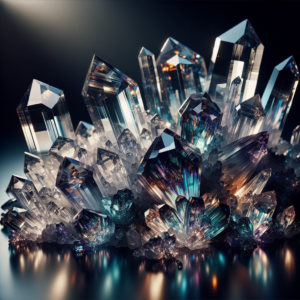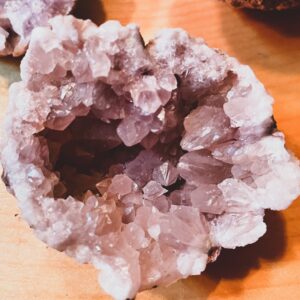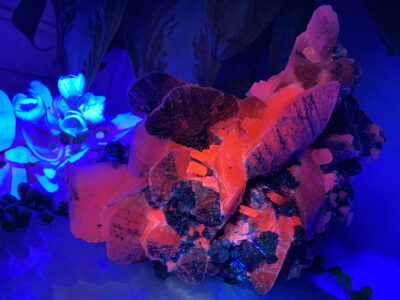I’ve always been fascinated by the shimmering world of crystals. Whether you’re a seasoned collector or just starting out, knowing how to identify these natural beauties can greatly enhance your appreciation and understanding of them. From amethyst to zincite, each crystal holds a unique story in its structure, color, and energetic properties.
Identifying crystals isn’t just about recognizing a stone by sight; it involves a deeper understanding of their physical and metaphysical aspects. It’s a skill that can help you choose the right crystals for your needs, whether you’re seeking healing, protection, or simply a stunning piece to add to your collection. Let’s dive into the basics of crystal identification and uncover the secrets each stone carries within.
Importance of Identifying Crystals
Identifying crystals accurately enhances my appreciation and understanding of their unique properties. This knowledge proves essential whether I’m selecting crystals for their metaphysical properties, aesthetic value, or potential healing benefits.
Reasons to Identify Different Crystals
- Enhanced Appreciation: Recognizing a crystal’s origin, composition, and history increases my respect for its place in natural history. For example, knowing amethyst is formed in volcanic rocks helps me connect with its ancient origins.
- Informed Selection: When I know how to identify crystals accurately, I make more informed decisions related to their use. For instance, choosing rose quartz specifically for its reputed emotional healing properties rather than just its appearance.
- Avoiding Fakes: With the knowledge of how real crystals look and feel, I avoid purchasing counterfeit crystals often sold in the market. I’ve learned how the genuine amethyst’s color differs subtly from dyed glass imitations.
- Maximizing Benefits: By identifying the right crystals, I ensure the maximum potential benefit, whether it’s for physical healing, emotional balance, or spiritual enhancement. For example, selecting clear quartz for its versatility in amplifying energy and intention.
- All Crystals are the Same: Many beginners believe that all pretty stones are beneficial, but each crystal has specific energies and properties that distinguish them significantly.
- Bigger is Better: Another common misconception is that larger crystals wield more power. However, size does not necessarily correlate with effectiveness; even small stones can be incredibly impactful.
- Price Equals Potency: Cost doesn’t always reflect a crystal’s healing properties. I’ve found some of the most affordable crystals are as potent as their pricier counterparts.
- Color is the Sole Indicator: While color can help identify a crystal, it isn’t the only characteristic to consider. Texture, clarity, and hardness also play crucial roles in identification, helping to determine not just what a crystal is, but also its quality and authenticity.
In my experience, the ability to identify different crystals accurately has profoundly enriched my personal and professional engagement with them. Knowing the real from the fake, the potent from the merely pretty, I make choices that truly enhance my life and the lives of those around me who seek the benefits of these remarkable natural wonders.
Tools and Techniques for Identifying Crystals
Identifying crystals accurately involves a mix of physical observation and technological intervention. I’ll explain the methods that ensure precision in identifying various types of crystals, enhancing both appreciation and understanding.
Physical Observation
When you look at a crystal physically, there are several attributes that help confirm its identity. The first is color, which, while useful, requires verification through additional characteristics. Observing a crystal’s form or shape provides insights, as many minerals form in unique structures. For instance, quartz typically develops long, six-sided columns with a pyramidal tip. Another key characteristic is the crystal’s luster; some might exhibit a glassy appearance while others could appear dull or metallic.
To test hardness, you can use the Mohs scale where minerals are rated on their ability to scratch or be scratched by others. A simple scratch test with common items like a coin or a piece of glass helps you determine where the crystal stands on the scale. Finally, consider the crystal’s cleavage and fracture patterns — these are the ways a crystal can break. They are crucial identifiers, often discerning similar-looking stones from one another.
Using Technology
Technological tools enhance the accuracy and detail in crystal identification efforts. One useful device is a refractometer, which measures the refractive index of a crystal — a constant number that reflects how much light a crystal bends. Through this, gems like diamonds and sapphires, which might look similar, show distinct readings.
Polariscopes are another valuable tool; they help determine the optical properties of a crystal by analyzing how it interacts with polarized light. This can be particularly important for distinguishing between natural and synthetic crystals. Moreover, X-ray diffraction stands out in identifying crystal structures at the atomic level, providing a definitive composition and internal structure.
For enthusiasts who are not able to access these sophisticated tools, many smartphone apps use image recognition technology to offer preliminary guesses about crystal types. These applications analyze photos of the crystals, comparing them to vast databases and suggesting possible matches based on visual similarities. However, while technology provides a starting point, validation through physical tests remains essential for accurate identification.
Popular Types of Crystals and Their Characteristics
Crystals fascinate me not only for their beauty but also for their varied properties and applications. Here, I’ll delve into some of the popular types of crystals, focusing specifically on quartz varieties and those known for their healing properties.
Quartz Varieties
Quartz is one of the most abundant and diverse minerals on Earth, making it a favorite among collectors and enthusiasts like myself. Here are some common types of quartz and their distinctive features:
- Clear Quartz: Known as the “master healer,” this crystal amplifies energy and thought, as well as the effect of other crystals. It’s characterized by its high clarity and lack of color, making it an all-purpose crystal in various healing contexts.
- Amethyst: This variety bears a striking purple color, which varies from light to deep hues. Amethyst is highly valued for its beauty and reputed calming and intuitive properties.
- Citrine: With its cheerful yellow to brownish color, citrine is prized for its beauty and supposed ability to attract wealth and prosperity.
- Rose Quartz: Distinguished by its delicate pink essence, rose quartz is widely recognized for its purported healing properties in matters of the heart and emotional support.
Each of these quartz types not only differs visually but also holds unique metaphysical characteristics that appeal to collectors and practitioners alike.
Healing Stones
Healing stones are sought after for their abilities to influence various aspects of personal well-being. Here are several well-known healing stones:
- Turquoise: Often valued for its striking blue-green color, this stone is believed to provide comfort and peace, aligning with my personal experiences during stressful times.
- Jade: Traditionally admired in Eastern cultures, jade symbolizes purity and serenity. It’s often used in practices that aim to cleanse one’s energy.
- Lapis Lazuli: Known for its deep blue color with golden inclusions of Pyrite, lapis lazuli supports wisdom and good judgment, fostering a deeper understanding of oneself.
- Obsidian: A highly protective stone, obsidian forms from quickly cooled volcanic lava and is considered powerful in shielding against emotional and environmental stress.
Incorporating these stones into my daily life, whether for meditation, decoration, or wearing them as jewelry, continually enhances my personal harmony and encourages emotional stability. Each stone’s unique properties offer distinct benefits, resonating deeply with those who use them consciously.
Practical Tips for Beginners
Initiating your journey into crystal identification can seem overwhelming, but I’m here to simplify the process. Here are some essential tips that will help beginners navigate the world of crystals with confidence and understanding.
Where to Start
Beginning your exploration of crystals involves understanding their basic attributes. First, familiarize yourself with a few common crystals, like quartz and amethyst. I recommend purchasing a good quality crystal identification guidebook or using reliable online resources that describe physical and metaphysical properties. Start by observing the color and hardness of each crystal. For example, amethyst typically exhibits a purple hue and has a hardness of 7 on the Mohs scale. Investing in a basic toolkit, which includes a hardness test kit and a magnifying glass, empowers you to perform initial assessments.
Avoiding Common Mistakes
When I started identifying crystals, I learned it’s easy to make errors without proper guidance. One common mistake is confusing crystals with similar appearances, such as blue lace agate and sodalite. To avoid this, always check multiple characteristics, not just color. Ensure you test each crystal’s hardness and cleavage, and if possible, consult more advanced identification tools like a refractometer. Another tip is to buy from reputable sellers to avoid accidentally purchasing synthetic or treated stones that mimic natural crystals. Remember, the cost of a crystal doesn’t always reflect its true value or effectiveness; it’s the authenticity and properties that count.
Conclusion
As we’ve explored the intricate world of crystals, I’ve shared my passion and insights to help you begin your journey with confidence. Remember, the key to truly appreciating and utilizing these natural wonders lies in accurate identification and understanding their deeper qualities. Whether you’re drawn to crystals for their healing properties or simply their beauty, each stone holds a unique energy waiting to be harnessed. By embracing the techniques and tools I’ve outlined, you’ll be well-equipped to select and appreciate crystals that resonate most profoundly with your needs. Start small, stay curious, and enjoy the enriching experience that each crystal brings into your life. Happy crystal hunting!
Frequently Asked Questions
What is the importance of identifying crystals correctly?
Identifying crystals accurately is crucial as it helps appreciate their origin, composition, and history. This knowledge assists in choosing crystals based on their metaphysical properties rather than mere appearance, leading to more informed and beneficial selections.
What common misconceptions exist about crystals?
Some prevalent misconceptions about crystals include the notion that all visually appealing stones are beneficial, larger crystals possess greater power, and higher prices indicate superior potency. In reality, these factors do not necessarily correlate with a crystal’s effectiveness.
What are some essential tools for crystal identification?
Essential tools for crystal identification include physical tools like refractometers, polariscopes, and X-ray diffraction equipment which offer precise details about a crystal’s composition. Handheld tools such as hardness testers and loupes are also valuable. Additionally, smartphone apps can provide a preliminary identification through image recognition.
How can one distinguish between different types of crystals?
Distinguishing between different types of crystals involves examining physical attributes like color, form, luster, and hardness. Using tools like the Mohs scale for hardness and observing cleavage patterns are effective methods. Technology such as refractometers can also provide detailed insights into a crystal’s properties.
What are some popular types of crystals and their properties?
Popular crystals include clear quartz, known as the “master healer,” amethyst for its calming effects, citrine for attracting wealth, and rose quartz for emotional support. Other notable stones are turquoise for protection, jade for prosperity, lapis lazuli for wisdom, and obsidian for grounding and protection.
What tips can help beginners in crystal identification?
Beginners should start with common, easily recognizable crystals such as quartz and amethyst. Investing in a good quality identification guidebook and a basic toolkit for initial assessments is advisable. It’s also important to purchase from reputable sellers to avoid synthetic or treated stones.
How does understanding a crystal’s properties enhance its use?
Understanding a crystal’s properties, both physical and metaphysical, allows users to select crystals that align with their specific needs and intentions, enhancing the crystal’s effectiveness in healing, protection, or attracting wealth. This makes the use of crystals more purposeful and satisfying.





















